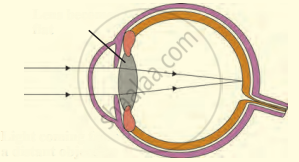Advertisements
Advertisements
प्रश्न
What happens to the image distance in the normal human eye when we decrease the distance of an object, say 10 m to 1 m? Justify your answer.
उत्तर
If the object distance is greater than 25 cm the image is always formed on the retina as the focal length of the human eye lens gets adjusted depending on the object distance. This special property of the human eye is called as power of accommodation. Hence, image distance will remain the same if object distance changes from 10 m to 1 m.
APPEARS IN
संबंधित प्रश्न
Draw a labelled sketch of the human eye.
Match the following:
| Column I | Column II |
| (i) Myopia | (a) Converging power of eye lens becomes low |
| (ii) Hypermetropia | (b) Converging power of eye lens remains the same |
| (c) Converging power of eye lens becomes high |
Draw a simple diagram of the human eye and label clearly the cornea, iris, pupil, ciliary muscles, eye-lens, retina, optic nerve and blind spot.
Describe the working of the human eye with the help of the above diagram.
Five persons A, B, C, D and E have diabetes, leukaemia, asthma, meningitis and hepatitis, respectively.
Which of these persons cannot donate eyes?
Differentiate between members of the following pair with reference to what is asked in bracket.
Rod and cone cells (pigment contained)
With reference to the functioning of the eye, answer the question that follow:
Name the cells of the retina and its respective pigments which get activated in the light.
Choose the correct answer :
The rods and cones of a vertebrate retina function is to _________
Write the name.
The part of human eye that transmits electrical signals to the brain.
The following figure show the change in the shape of the lens while seeing distant and nearby objects. Complete the figures by correctly labelling the diagram.

